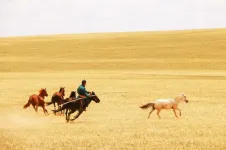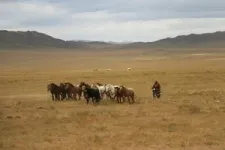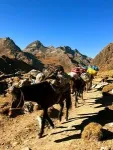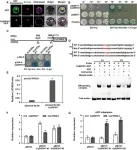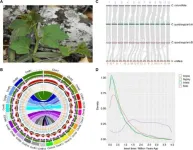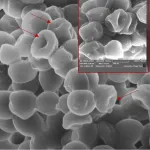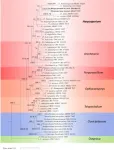(Press-News.org) 1. An international research team sequenced the genomes of hundreds of horse archaeological remains to track the historical rise of horse-based mobility around 4200 years ago in the Pontic-Caspian steppes.
2. The emergence of improved breeding techniques at the time considerably enhanced the yearly capacity of horse production, which helped spreading domestic horses like a wildfire across the whole Eurasian continent.
3. The massive human migrations that spread Indo-European languages outside the steppes around 5,000 years ago were not mediated by horses, contrarily to what was previously thought.
All domestic horses living on the planet today, whether racetrack champions, pony-club companions, or heavy draft giants, find their origins in the western Russian steppes of the third millennium BCE. However, the exact chronology of horse domestication and the widespread integration of horse power into human societies remained highly debated. A new study published by Nature on June 6th reports that the proliferation of domestic horses started by the end of the third millennium BCE, around ~4,200 years ago. This date marks the start of a new era in human history, in which horses considerably speeded up communication and trade networks across Eurasia, catalyzing unprecedented exchanges and interactions among diverse cultures. This work was coordinated by Ludovic Orlando, director of the Centre of Anthropobiology and Genomics of Toulouse (CAGT, CNRS/Université Paul Sabatier), and involved 133 researchers from 113 institutions around the world.
The research team gathered an extensive collection of horse archaeological remains spanning the Eurasian continent. They combined radiocarbon dating with ancient DNA sequencing to characterize a comprehensive genome time-series providing fine-grained resolution into the genetic transformations coinciding with the emergence of equestrianism.
“I have started working on horses about a decade ago. At that time, we only had a handful of ancient genomes. With this new work, we now have several hundreds. It was particularly important to gain resolution into Central Europe, the Carpathian and the Transylvanian basins, as this area was central to ongoing debates about horseback riding driving the massive migrations from the steppes around ~5,000 years ago, and possibly earlier.”, said Pablo Librado, first author of the study, and now Tenured Scientist at the Institut de Biologia Evolutiva of Barcelona (IBE), a joint centre of the CSIC and the Universitat Pompeu Fabra.
The research team scrutinized their data for three indicators of horse husbandry. First, they traced when the progenitors of modern domestic horses began to spread outside their native domestication homeland. Next, they reconstructed the horse demography all along the third millennium BCE to precisely date the earliest signs of breeding and large-scale production of horses. Last, they uncovered evidence of significant shifts in the horse reproductive lifespan, indicating deliberate manipulation of animal reproduction by early breeders. The remarkable alignment of all three lines of evidence around ~4,200 years ago strongly suggests that domestic horses were produced in sufficiently large numbers to sustain a growing demand across the continent only then, and not earlier. Therefore, the date of ~4,200 years ago marks the true onset of horse-based mobility as we recognize it. Horse-based mobility persisted as the fastest mode of terrestrial transportation until the advent of mechanical engines in the 20th century.
Yet, ancient DNA research had depicted earlier changes in the genetic landscape of Europeans, during the first half of the third millennium BCE, following the massive expansion of people coming from the steppes, and often considered speakers of a proto-Indo-European language. Since the horse genetic map started to change much later, the research team could discount horseback riding as a driving force for the success of those human migrations, despite horse-related terminology forming a common basis to most Indo-European languages.
“One question that puzzled me for years pertains to the scale of the production: how could such a substantial number of horses be bred so suddenly from a relatively small domestication area to meet the increasingly global demand by the turn of the second millennium BCE? Now we have an answer. Breeders controlled the reproduction of the animal so well that they almost halved the time interval between two generations. Put simply, they were able to accelerate the breeding process, effectively doubling their production rate.”, added Ludovic Orlando.
The methodology developed in this study for measuring generation times is new, and leverages the full potential of ancient genome time series. As genomes evolve, they accumulate mutations and recombine every generation. The number of mutations they carry and DNA cross-overs they went through provide a direct measure for the multitude of generations leading to them. When coupled with radiocarbon dates, the numbers of generations can be converted into calendar years. The research team found that more generations accumulated in the last two centuries, concurring with the emergence of many modern bloodlines through intensive selective breeding. Strikingly, the generational clock was also found to tick faster around ~4,200 years ago, right at the time when the mass production and geographic diffusion of domestic horses started.
“Our methodology for measuring temporal changes in generation times holds great potential. It arms the archaeozoological toolkit with a new way to monitor the development of controlled breeding across various domestic species beyond horses. But it can also help elucidate the generation interval in our hunter-gatherer ancestors and how these intervals evolved alongside shifts in lifestyle or significant climatic changes.” adds Pablo Librado, who developed the underlying statistical framework.
For now, and sticking to horses, the research team also reported exceptionally brief generational intervals within a distinct lineage, separate from that leading to modern domestic horses. This lineage was excavated at Botai, a site from Central Asia where evidence of horse milking, harnessing and corralling has been both reported and debated. The discovery of shortened generation times identified adds credit to models depicting settled human groups domesticating the horse in the region to secure consistent access to resources such as meat and milk, which were vital for their subsistence. The Botai people, however, did not engage in extensive long-distance migrations alongside their horses, since the genetic makeup of their horses remained local and did not expand across Eurasia.
“Our evidence supports two domestications in horses. The first, occurring around ~5,500 years ago, aimed to address the decline in horse populations and provide sustenance for populations inhabiting the steppes of Central Asia. The domestic horse as we know it emerged around ~4,200 years ago from the second domestication. This one truly transformed human history by providing fast mobility for the first time.”, concluded Ludovic Orlando.
This work was mainly supported by the European Research Council (CoG PEGASUS, and SyG Horsepower).
END
The rise of horse power ~4,200 years ago
2024-06-06
ELSE PRESS RELEASES FROM THIS DATE:
Adding nurse case managers to telehealth significantly lowers blood pressure in Black and Hispanic stroke survivors
2024-06-06
Low-income Black and Hispanic stroke survivors with uncontrolled hypertension had a more than two-fold reduction in blood pressure when they tracked it at home and sent their readings to a nurse case manager. The gains were in systolic blood pressure specifically at one year into the study and when compared to a similar group of patients who did not have access to a nurse.
Led by researchers at NYU Langone, the study is the first to examine differences in home blood pressure monitoring with or without nurse case management. Further, the findings, published online June 6 in the Journal of the American Medical Association (JAMA), addressed controlling hypertension in low-income ...
The gut’s stem cells get a new identity
2024-06-06
Two independent studies by Columbia scientists suggest that research into the gut’s stem cells over the past 15 years has been marred by a case of mistaken identity: Scientists have been studying the wrong cell.
Both studies were published online today in the journal Cell.
The gut’s stem cells are some of the hardest-working stem cells in the body. They work continuously throughout our lives to replenish the short-lived cells that line our intestines. About every four days, these cells—covering a surface about the size of a tennis court—are completely replaced.
Understanding these workaholic stem cells could help scientists turn ...
The World Cultural Council (WCC) is pleased to announce the names of the 2024 Awards
2024-06-06
SCIENCE
Professor Eske Willerslev, Professor of Evolutionary Biology at the University of Copenhagen and Prince Philip Professor at the University of Cambridge, has been selected as the winner of the Albert Einstein World Award of Science 2024.
The prize is granted in recognition of the numerous breakthroughs in evolutionary genetics Prof. Willerslev’s has made during his highly fruitful career. The award recognizes his pioneering contributions in establishing the field of Environmental DNA and the sequencing of ancient DNA to track the origins and interactions of human population groups.
During his doctoral studies, Prof. Willerslev published ...
Citrus saviors: discovering the genetic defense against Huanglongbing disease
2024-06-06
A recent study has pinpointed two key enzymes in Citrus sinensis that play a crucial role in the plant's defense mechanism against the Asian citrus psyllid (ACP), a vector for the lethal huanglongbing (HLB) disease. This research offers a promising lead in the battle against a disease that has caused significant losses in the citrus industry.
The citrus industry faces major challenges from Huanglongbing (HLB) disease, transmitted by the Asian citrus psyllid (ACP). Traditional control methods are often ineffective and environmentally harmful. The need for innovative and sustainable pest management strategies is ...
Desert hero unveiled: Cissus quadrangularis genome decodes drought survival tactics
2024-06-06
In a recent study, scientists have unlocked the genetic secrets of Cissus quadrangularis, a plant that flourishes in the harshest of desert climates. The discovery of its adaptive traits and the Crassulacean acid metabolism (CAM) pathway marks a significant leap forward in the quest for drought-resistant crops.
As water scarcity looms as a major threat to global ecosystems and food production, the quest to understand how plants like Cissus quadrangularis conquer arid landscapes is more critical than ever. The genetic blueprint of such species could hold the key to enhancing ...
Afib patients on low doses of blood thinners have more bleeding episodes than those on standard doses
2024-06-06
(WASHINGTON, June 6, 2024) – Patients with atrial fibrillation (Afib) who took low doses of blood-thinning medications known as direct oral anticoagulants (DOACs) experienced more bleeding episodes during the first three months of treatment and about one in five had high blood levels of the medications, compared with similar patients who took standard doses of the same medications, according to a study published in Blood Advances.
Patients with Afib, a common type of arrhythmia, or ...
Severity of calls to US poison centers increases sharply for both adults, kids
2024-06-06
America’s poison centers are fielding increasingly severe cases that are dramatically more likely to lead to severe harm or death in both adults and children, a new study from the University of Virginia School of Medicine reveals.
The number of calls about intentional exposures that resulted in death among adults increased a whopping 233.9% between the beginning of 2007 and the end of 2021, the study reveals. “Intentional exposures” include cases such as suicide attempts, use of illegal drugs and ...
Novel diamond quantum magnetometer for ambient condition magnetoencephalography
2024-06-06
Magnetoencephalography (MEG) is a biomedical imaging technique used for mapping brain activity by recording magnetic fields produced by the naturally occurring electrical currents generated by neurons in the brain, using very sensitive magnetometers. Currently, MEG requires a magnetically shielded room for operation. Achieving MEG that works in normal environments, without the need for magnetic shielding, is a major goal. This would enable daily diagnosis, brain-machine interfaces, and fundamental research on brain function.
Magnetometers using diamond quantum sensors with nitrogen–vacancy (NV) centers are promising candidates for realizing ambient ...
Novel lipopeptide proves lethal against Staphylococcus areus
2024-06-06
A novel antibacterial lipopeptide produced by the bacterium Serratia marcescens has been shown to be highly effective in killing Staphylococcus aureus – one of the most important pathogens occurring in humans.
Staphylococcus aureus is one of the five most common causes of hospital-acquired infections and is often the cause of life-threatening infections following surgery. Since the introduction of antibiotics in the early 1940s, S. aureus has by now developed resistance against most classes of antibiotics, ...
Harposporium incensis sp. nov., a South American cordycipitoid species exhibiting inter-phylum host-jumping and having potential as a biological control agent for pest management
2024-06-06
The genus of Harposporium belongs to the Ascomycota of the Fungi kingdom, the class Sortariomycetes, the order Hypocreales, and the family Ophiocordyceiaceae, is a common genus of soil fungi. The species of Harposporium are pathogens of nematodes, with some also infecting rotifers or tardigrades, and has significant ecological value. In recent years, studies have shown that a few species of the genus Harposporium can also parasitize insects or other invertebrates, such as H. janus, which can infect beetles in the Coleoptera family. However, so far, it has not been found that the same species in this genus can parasitize different invertebrates in both sexual and asexual stages. Is there a ...
